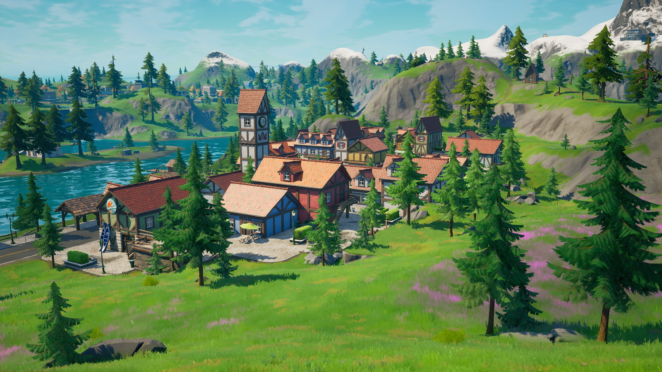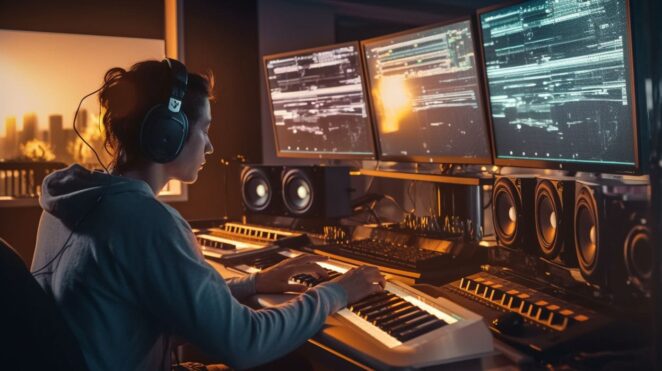The elements of art in gaming, often referred to as “game aesthetics” or “game art elements,” are the foundational components that contribute to a video game’s overall visual and emotional experience. These elements are critical in shaping a game’s atmosphere, engagement, and storytelling.
The elements of art in gaming include;
Environment design

The worlds in which players explore, battle, and adventure are key to creating a captivating and immersive experience. Carefully crafted environments provide the backdrop for the game’s action and serve as a storytelling device.
- Level design: Thoughtful design can challenge and engage players while ensuring that game spaces are logically structured and navigable.
- Architecture and landmarks: Unique architectural styles and memorable landmarks can make the game world more alive and coherent.
- Ambience and lighting: Utilizing ambient sounds, dynamic weather systems, and varied lighting can set the mood, evoke specific emotions, and create an atmosphere.
- Environmental storytelling: Integrating subtle visual clues, such as graffiti on a wall or scattered journals, can help convey the game’s narrative and backstory without relying solely on explicit exposition.
Character design
Characters are the heart and soul of the art games. From protagonists to supporting roles, a game’s cast of characters can leave a lasting impression on players. Some components that make for memorable character designs are:
- Appearance: Striking visuals, such as unique outfits, hairstyles, and facial features, make characters recognizable and appealing.
- Personality: Giving characters distinct personalities captivates gamers and encourages emotional investment.
Environment design
A game’s environment can either be captivating or feel empty and uninviting. Successful game environments entertain and immerse the player while setting the stage for storytelling and gameplay mechanics. Crucial aspects of environmental design include:
- World-building: Establishing believable, immersive worlds requires deep knowledge of architecture, ecology, and culture and should be consistent with the game’s overall theme.
- Level design: Crafting entertaining levels is essential to improving the gameplay experience. This encompasses elements such as the layout, obstacles, puzzles, and more.
- Atmosphere: A well-designed atmosphere can evoke emotions and direct the player’s attention to specific areas or activities.
Sound and music

Sound and music are often underrated in tying together the gaming experience. When done correctly, they complement the visuals and enhance the overall atmosphere. Key aspects of sound and music in gaming include:
- Sound effects: SFX set the stage for immersion by bringing life to the game’s world. The sounds of weapons, footsteps, and the environment contribute to player engagement and immersion.
- Game music: Music sets the tone and mood and can evoke emotions that resonate with the players. A fitting soundtrack amplifies.
Narrative and storytelling
A game’s narrative can be as important as its visuals and gameplay. Avid gamers often appreciate compelling stories, helping them relate to the characters and become emotionally invested in their journey. Storytelling elements in games include:
- Character development: Interesting and well-developed characters can make a game’s story memorable. Effective character building brings these individuals to life, giving them motivations, strengths, and weaknesses that make them relatable.
- Plot structure: Just like books and movies, games can benefit from a well-structured plot. This includes a captivating beginning, escalating conflict, and satisfying resolution.
- World-building: Richly crafted fictional worlds help create an immersive environment where players can lose themselves. Detailed, intricate settings with their history, culture, and lore add depth to the gaming experience.
Animation and motion
Discussion of gaming art would only be complete with addressing animation and motion. Smooth and lifelike animation heightens the sensation of immersion, further connecting the player to the game world. Key aspects of game animation include:
- Character animation: Through realistic, consistent, and personality-driven character animations, players develop a stronger emotional attachment to the game’s characters.
- Environmental animation: Flourishing, dynamic environments help bring the in-game.
Gameplay mechanics and interactivity

These elements determine the overall enjoyment and replay value. Crucial aspects to consider include:
- Controls: Intuitive and responsive controls are the backbone of any game. The fluid movement and combat of Hollow Knight exemplify tight, responsive controls.
- Game design: Creative gameplay ideas create a unique gaming experience. Titles like Portal or The Witness showcase innovative game design that challenges players to think differently.
- Balance: Ensuring gameplay is balanced prevents players from feeling frustrated or lost. Celeste’s difficulty adjustment and level design offer a great example of a well-balanced game.
Future Perspectives on Game Aesthetics
Looking forward, as technology advances and the potential for gaming expands, the elements of art in gaming will likely evolve and become even more intricate. Emerging technologies such as virtual reality (VR) and augmented reality (AR) are opening up new avenues for game developers to explore the boundaries of immersion and interactivity.
Virtual Reality: VR can make use of all the aforementioned game aesthetics, but with an added layer of immersion. For example, environmental designs will not just be backdrops but 360-degree worlds in which players are truly ‘inside’. Sound design takes on heightened importance, as 3D spatial audio can direct a player’s attention or hint at threats lurking just behind them.
Augmented Reality: AR games overlay virtual elements onto the real world. This presents a unique challenge for artists and designers, as they must integrate their designs seamlessly into diverse real-world environments. Game aesthetics in AR will need to be adaptive and responsive to the player’s surroundings.
Procedural Generation: With the rise of games like No Man’s Sky, procedural generation – where game worlds are created algorithmically rather than being manually designed – is becoming more prevalent. This offers a unique challenge for game aesthetics, as artists and designers must establish guidelines and rulesets for algorithms to follow, ensuring the generated worlds are visually pleasing and logically sound.
Inclusive Design: As the gaming community grows more diverse, there’s an increasing demand for representation and inclusivity. Future game aesthetics will likely place more emphasis on diverse character designs, narratives that resonate with a wider audience, and settings inspired by various cultures and histories.
User-generated Content: Platforms like Roblox and Minecraft have shown the power of user-generated content. As such platforms gain popularity, the lines between game developers and players will blur. Players, equipped with tools provided by developers, will craft their own masterpieces, leading to an even richer tapestry of game aesthetics.
In conclusion, while the foundational elements of game aesthetics might remain consistent, the ways in which they are implemented and experienced will continually evolve. As the gaming industry pushes the boundaries of what’s possible, players can look forward to ever-more enriching, immersive, and diverse virtual worlds.
Wrapping up
These elements of art in gaming work together to create a holistic and memorable gaming experience. Game developers carefully consider these factors to ensure their games resonate with players and deliver on the intended emotional and aesthetic goals.




